Matador Network's Blog, page 1111
April 26, 2019
Da Vinci Louvre exhibit tickets

A huge Leonardo da Vinci exhibit is coming to the Louvre this fall, and to handle the massive turnout that’s expected, the museum is implementing a special policy requiring patrons to purchase timed tickets in advance. Jean-Luc Martinez, the Louvre’s president-director, told Art Newspaper, “This will enable us to manage the flow of visitors and prevent them from queuing. It’s about changing our visitors’ habits.”
The da Vinci exhibition will mark the fifth centenary of his death, and feature collections of several da Vinci masterpieces, including the Mona Lisa, The Virgin of the Rocks, La Belle Ferronniere, Saint John the Baptist, and Saint Anne. A selection of the artist’s drawings will also be shown, along with sculptures and paintings by other artists to provide context to da Vinci’s work.
According to the exhibit’s website, “This international retrospective will present the latest research findings, critical editions of key documents and the results of the latest analysis carried out in laboratories or during recent conservation treatment by the Louvre.”
Reservations will be available online, with tickets sold at 30-minute intervals. Even visitors who normally attend the museum for free, including children and veterans, will be required to make reservations in advance. The online ticket system has worked for the Louvre in the past, including the 2017 Vermeer show and last year’s Delacroix retrospective. The museum sees an average of 25,00 to 50,000 visitors a day, so new methods of crowd control are always being tested.
The da Vinci exhibition is scheduled to launch in October, with tickets available on the website. 
H/T: Smithsonian.com

More like this: How to crush the Louvre in one day
The post The Louvre’s huge, upcoming da Vinci exhibit will require advance tickets appeared first on Matador Network.

Photo ops destroying Dutch tulips

The Netherlands’ iconic flower is suffering from a serious case of Instagram madness. Tourists who want the perfect selfie with the beautiful flowers have been trampling fields of tulips, causing farmers to suffer thousands of dollars in damage.
To encourage tourists to be more responsible when venturing into tulip fields, the Dutch tourist board has launched a campaign designed to remind people to take “tulip-friendly selfies” from outside the fields, using the hashtag #watchyourfeet.
Perhaps unwilling to put all their eggs in the #watchyourfeet basket, farmers have taken matters into their own hands, installing fences around tulip fields that encourage visitors to enjoy the view from afar. Signs in English and Chinese read: “Enjoy the Flowers, Respect Our Pride.” According to the Noordwijkerhout tourist office, a village southwest of Amsterdam, a group of 40 voluntary guides or “ambassadors” will be on hand to teach visitors about the history of tulip fields and remind them why it’s important to respect the colorful landscape.
The Netherlands tourism board has even published a list of dos and don’ts for flower-crazed visitors to know exactly what is expected of them.
The Netherlands, especially Amsterdam, is trying hard to deal with its overtourism issue. Measures include introducing tougher regulations on Airbnb, implementing a seven percent tourist tax, and restricting the development of new hotels and tourist-centric shops. Recently, guided tours of the red-light district have also been banned to reduce disturbance for local residents. 
H/T: Lonely Planet

More like this: The Netherlands’ most iconic symbol is actually from Turkey
The post Dutch tourist board wants Instagrammers to stop trampling tulips appeared first on Matador Network.

SAS pilot strike cancels flights

After SAS pilots in Norway, Sweden, and Denmark went on strike, the airline has canceled hundreds of flights around the world. As of right now, 673 flights have been canceled, impacting 72,000 passengers. Seventy percent of the flights are canceled for today and Saturday, wrecking the travel plans of about 170,000 passengers. The strike is a response to the breakdown of negotiations over pay and work schedules between pilot associations and Scandinavian Airlines.
SAS had apologized to passengers for the inconvenience, and is pledging to come to an agreement with pilots as soon as possible. It did, however, warn that meeting the pilots’ demands would have negative consequences for the airline. Indeed, the airline is currently in the midst of updating its aging fleet of planes, and faces stiff competition from budget airlines like Ryanair, easyJet, and Norwegian.
Pilots currently earn an average of $9,700 per month, but are asking for a 13 percent wage increase. The demands also include changes to pilots’ work schedules. According to a statement from the SAS Pilot Group, “Many SAS pilots have no control over when and how long they have to work. In a worst case scenario, they risk having to work seven weekends in a row.”
If you happen to have an SAS flight booked for this weekend or next week, you are advised to check the dedicated page for all information about traffic disruptions, which is continuously updated. 
H/T: BBC

More like this: The 10 best airlines to travel in economy
The post SAS pilot strike strands thousands of passengers appeared first on Matador Network.

Best wine-themed hotels in the world

Humans love wine. We’ve been making it since around 6000 BC, and have spread vines to all corners of the earth. But while everyone loves a nice glass at the end of a long day, true appreciation and enjoyment of wine and its production process is often thought of as the purview of the wealthy, the elite, those who have the time and money to travel, sip, and truly understand wine. The wine-focused hotels around the world usually follow suit and, while gorgeous, are often extravagantly priced, far out of reach of most wine lovers’ wallets.
Yet a wave of up-and-coming winemakers and people working in the wine tourism industry have recently started showing the world that enjoying wine and having a boozy wine-filled vacation doesn’t have to conform to old norms. From constructing a hotel out of wine barrels to making wine in the hotel’s basement, here are the coolest wine hotels around the world.
1. Winebox Valparaiso — Valparaíso, Chile

Photo: WineBox Valparaiso/Facebook
Stacked shipping containers? Check. Eye-catching street art and murals? Check. Killer view? Check. Tons of wine? Absolutely. Despite being located a short drive from several of Chile’s finest wine valleys, the coastal city of Valparaíso — famous for its street art, bohemian vibes, and steep hills cluttered with colorful houses — was for years lacking a wine hotel until Winebox Valparaiso.
The dreamchild of winemaker Grant Phelps and designed by his partner Camila Ulloa, Winebox is constructed out of discontinued shipping containers from the local port. Each is a spacious and light-filled room with a bedroom, bathroom, kitchen, and ocean view terrace and window. In keeping with Phelp’s waste reduction goal, decommissioned or old elements of the wine-making process find new life as decor and furniture: bottles become light fixtures, barrels become stools.
The outside and walls of the 21 rooms are covered in splashy artwork by local and international artists, and the rooftop bar offers an unbeatable panoramic view of the city and bay. Wine tastings are practically an everyday occurrence. It also has the distinction of being Chile’s first urban winery, preparing and aging its wine in the basement. In the future, Phelp hopes to offer tours to the nearby wine valleys and other wine-oriented activities and amenities.
2. The Yeatman — Porto, Portugal

Photo: The Yeatman/Facebook
Portugal also has a long history with vinho, though it’s often overshadowed by its more famous wine-making cousins like France and Italy. Grapes for wine have been grown there since 2000 BC, and in the 1700s, the world became obsessed with port wine, a fortified dessert wine that helped Portugal gain international prestige. With the vineyards and wineries of the Douro Valley a short distance from town, Porto embraces its wine legacy in many aspects of its culture, including hospitality.
There’s a dearth of wine-themed hotels in Porto, but the Yeatman stands apart for its unique incorporation of wine-making paraphernalia into the design and decor, keeping it classy but still interesting. Stacked on grassy terraces overlooking the Douro River and the city, the exterior design of white walls and red stucco tiled roof may seem pretty standard, but look closer. In the Master and Presidential suites, the beds are set inside giant hollowed out wine barrels that stretch from floor to ceiling, the outdoor pool is shaped like a wine decanter, and in the spa, you can relax in a barrel bath filled with red wine extract. It’s not every day you get to bathe and sleep inside of a barrel, and of course, wine activities like classes, tastings, and other spa treatments are also available.
3. Entre Cielos — Mendoza, Argentina
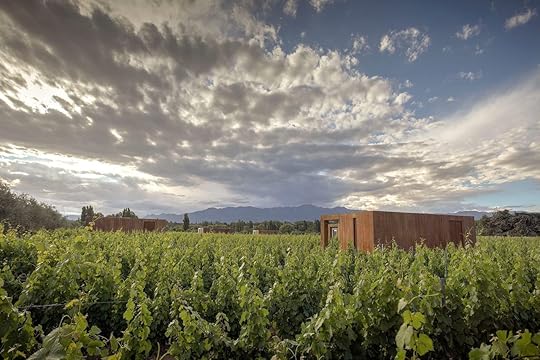
Photo: Entre Cielos/Facebook
Mendoza is Argentine wine country and the home of silky malbec growing in the shadow of the imposing Andes. Drawing a huge crowd for wine tourism, there’s no end of wine hotels, but the boutique outfit Entre Cielos knows how to rise above the rest — literally.
The main body of the hotel is a low-slung building on the outskirts of the vineyard, but out in the middle of the vines themselves is the hotel’s prized Suite Loft. The suite itself looks like a space capsule: a circular white tube elevated above the vines on stilts, with a minimalist white interior. There’s a queen bed, living area, skylight, and back terrace with a hot tub. Set apart from the main hotel and isolated in the vineyard, there’s peace and quiet to sip glasses of wine from nearby wineries. In terms of activities, there’s wine tastings and tours of Mendoza and the surrounding wine country, as well as a spa and hammam.
4. Jackalope — Mornington Peninsula, Australia

Photo: Jackalope Mornington Peninsula/Facebook
To find this slick and ultra-modern wine hotel on the Mornington Peninsula in Australia, just keep an eye out for the giant sculpture of a jackalope in the front yard.
In a nod to the distinctive stylings of film director David Lynch, Jackalope is all about keeping it surreal. The suites are referred to as “lairs,” the hallways are moodily lit by blue neon, the ceiling of the restaurant is lit with 10,000 bulbs, and the lobby’s glass wine vault is illuminated by golden lights exuding a sci-fi aura. Sharp angles, asymmetrically shaped walls and windows, starkly minimalist decor, and a black and white color palette with gold and copper accents complete the slightly off-kilter vibe. The two-story hotel, with a back patio and infinity pool, looks out over the immaculate Willow Creek Vineyard, and the onsite restaurants and bar serve excellent vintages from the surrounding vineyards. The hotel also features rotating art installations from acclaimed artists. Currently, it hosts the Rain Room, a giant interactive room where rain falls from the ceiling all around you but not on you, thanks to sensors that detect and respond to your movements. An extremely dynamic space, Jackalope is a great fit for wine lovers who crave the bizarre and vaguely sinister.
5. Schlafen im Weinfass — Sasbachwalden, Germany
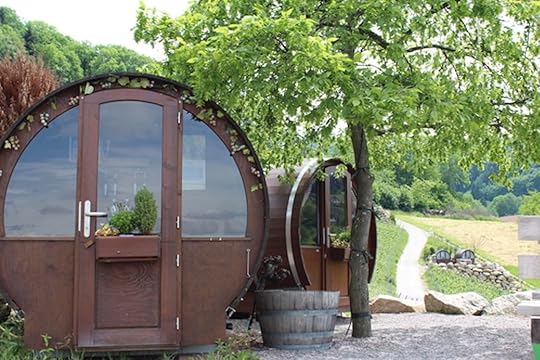
Photo: Schlafen im Weinfass
Schlafen im Weinfass is a winery, farm, and hotel that sits on a hill overlooking the village of Sasbachwalden in the Black Forest region of Germany. Giant barrels — each of which used to hold 8,000 liters of wine — have been converted into rooms spaced out along roads running through the vineyard. Each has a cozy bedroom, bathroom, and windows looking out over the vines and valley. The different barrel rooms are named after the wine they used to hold, and guests are treated to complimentary bottles of wine, breakfast, and other amenities during their stay. It’s also easy to drive around the valley to see the sights and visit nearby vineyards along the historic Baden wine route.
6. Campera Hotel — Valle de Guadalupe, Mexico

Photo: Campera Hotel Burbuja/Facebook
Ever get the sense you’re living in a bubble? At this new hotel in the Valle de Guadalupe wine-growing region of Mexico, that’s not a bad thing — the rooms are literally giant bubbles overlooking the vineyard.
The inflatable, eco-friendly bubble rooms each have a large circular window that looks out onto the Docepiedras vineyard. Each Martian-esque bubble comes with a four-poster queen bed, bathroom, and amenities like AC. The minibar is stocked with red and white wine from the nearby vineyard. Campera Hotel’s prime location right in the heart of Valle de Guadalupe makes it easy to drive to the different wineries for tours and tastings.
7. Quinta da Pacheca — Douro Valley, Portugal

Photo: Quinta da Pacheca/Facebook
Located in the Douro Valley, the heart of Portuguese wine country, the Quinta da Pacheca winery and vineyard has been a fixture of the area since the 16th century. In addition to producing excellent wines and olive oil, it also has a luxury hotel, but for guests seeking a more “immersed” experience, they can sleep in one of the property’s 10 wine barrel rooms.
Made from pine, the interior furnishings are sparse but refined: a circular bed facing a circular window that opens up onto a private back patio with chairs looking out over the vineyard. The views from the back patio are sublime. The vineyards fan out along the hills, and, to complete the scene, the tranquil Douro River glides by next to the vineyard, visible from the barrels. Each barrel also has a modern bathroom with a walk-in shower, AC, skylight, and Wi-Fi. In addition, there are wine tastings, a wine-making room where guests can learn about the process, and an onsite restaurant. 

More like this: The 7 most exciting places to travel to drink wine in 2019
The post The coolest wine hotels around the world appeared first on Matador Network.

April 25, 2019
Historic sites opening around Rome

Rome certainly isn’t lacking in historic sites, but that doesn’t mean they’re all open to the public. From April 25 to April 28, however, several monasteries, parks, and historic palaces that are usually closed will be open to the public in an event called the Dimore Storiche del Lazio. The aim is to showcase the hidden treasures of the Lazio region, which encompasses Rome. While most visitors to Italy find their way to Rome at some point during their trip, many often bypass the rest of the Lazio region in favor of the more popular Tuscany.

Photo: Rete Delle Dimore Storiche del Lazio
Lazio, however, has a lot to offer, including the Palazzo Chigi in Ariccia — designed by Bernini — the Castello Borghese a Pratic del Mare in Pomezia, which belonged to the noble Borghese family, and the Renaissance-era Palazzo Ruspoli — still home to princesses Maria Pia and Giacinta Ruspoli — in the coastal town of Cerveteri.
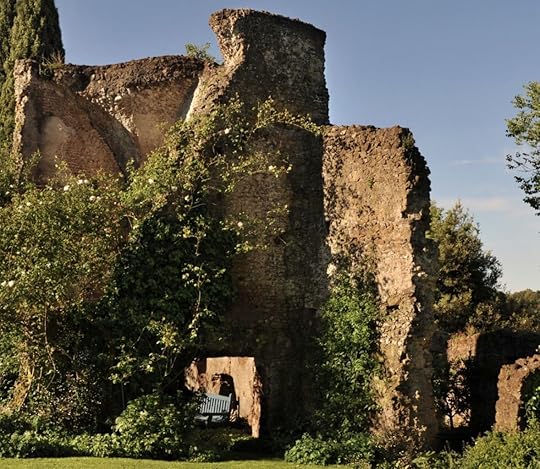
Photo: Rete Delle Dimore Storiche del Lazio
There are a total of 29 sites now open for exploration in the Lazio. In addition to Lazio, the nearby province of Viterbo will open 16 sites, Latina will open 13, Frosinone will open nine, and Rieti will open six. Several sites inside Rome, like the Palazzo Doria Pamphilj al Corso, typically charge entry fees while others, like the Collegio Innocenziano, are normally closed to the public.

Photo: Rete Delle Dimore Storiche del Lazio
In addition to all sites being free during the Dimore Storiche del Lazio period, there will also be a series of performances and local product tasting at select sites. However, a limit will be placed on the number of people allowed entry with advance reservations required. To reserve your spot for any attraction, email dimorestoriche@tosc.it or call +39-063-281-0961. 
H/T: The Points Guy

More like this: Where to eat in Trastevere, Rome’s beloved Bohemian neighborhood
The post Dozens of off-limits historic sites around Rome are opening to the public appeared first on Matador Network.

Airbnb music lessons and experiences

Airbnb is hardly just about B&Bs anymore. Moving into the experiential travel realm, the amateur lodging behemoth has become as much about finding unique, local experiences when you travel as it is finding a place to sleep. Sure, stuff like hiking to hidden waterfalls and feeding baby manatees is fun, but nothing delves into its culture like experiencing its music. That’s why Airbnb has a whole category devoted to musical experiences, whether it’s becoming a K-pop star in Seoul, a DJ in Berlin, or a music “influencer” in LA. Here are a dozen music experiences you might want to book as part of your next vacation.
Yodeling workshop in Salzburg
Cost: $53

Photo: Smit/Shutterstock
If you come back from Austria and didn’t learn to yodel, did you really even go to Austria? Such questions won’t be necessary after your day with Anita, who in addition to teaching you to yodel will also show you how yodeling helps improve your mental state and relaxation. Like falsetto yoga, the workshop starts with learning proper posture and breathing, then an introduction to what she describes as “a beatbox style of yodeling.” Then you’ll move on to learn the typical “Jucizer,” “Jodelruf,” and “Jodelgesang,” singing to the Alps with your newfound vocal skills, where you can have your very own Sound of Music twirling moment.
Play with a DJ in Berlin
Cost: $80
Berlin is renowned for its crazy, beat-pumping nightclubs. And while it’s certainly fun to club-hop, you’ll get even more immersed when you spend a day with Bruno Otranto, a DJ who’s played in clubs around the world. The afternoon will take place at the famous Berliner RockHaus, where you and your crew will learn the history of Berlin club culture from the fall of the wall to today. Then, you’ll get tips on how to mix tracks using both vinyl and digital, creating your own set to take home and insist on playing at your next house party. From there, the group moves to what Oscar describes as “one of the most infamous bars in Berlin,” where he’ll give you pointers on how to “blow up any dance floor.” Figuratively, we assume.
Discover flamenco guitar in Seville, Spain
Cost: $58

Photo: javi_indy/Shutterstock
Ever dream of just saying “screw it,” quitting your job, and moving to Spain to pursue flamenco guitar? Well, that’s exactly what Leah did, and now she’ll teach everyone from beginners to experienced guitarists the finer points of playing flamenco. After learning the musical structures and rhythms that make the style so irresistible, you’ll make a short video of yourself playing to post on every social media channel possible. Then, over refreshments, you’ll learn the history of flamenco, as well as the best spots around town to hear it and, if you’re inspired, dance as well.
Record a song with a real pop star/social media influencer in Los Angeles
Cost: $78
Though we’re not really sure what a “verified social media influencer” is, Leila Pari apparently is one and will bring you along on a day of creativity and music, taking a song from idea to inception. You’ll begin by learning how one goes about taking the words in their head and putting them to melodies. Then, working with Leila, you’ll craft a song, record it, and take it home with you to share. The experience seems to be very popular among younger teens and makes a great gift for the aspiring influencer in your life.
Be a K-pop singer in South Korea
Cost: $172

Photo: TORWAISTUDIO/Shutterstock
It doesn’t get much more Gangnam Style than making your very own K-pop video at King Studio, right in the heart of Seoul’s tony Gangnam neighborhood. Kingsman, who by trade is a K-pop recording and mixing engineer, guides you through the process of recording a song of your choice, teaching you the proper notes, beats, and pronunciation to create a hit record. Can’t sing your way out of a shower? Neither can a lot of pros! That’s what you’ve got three hours of tuning for! After cutting your demo, you’ll be given a 30-second music video of the experience, edited from your day of singing. Plus a CD to take home and play for everyone in your car, claiming it’s a “hot new track I heard on my trip to Seoul.”
Learn to play the saxophone in Hong Kong
Cost: $53
Naturally, the place one learns to play the saxophone is Hong Kong, right? That’s the theory behind this workshop with Stephen, a Berklee College of Music alum who’ll spend the day teaching you all about the sax. He begins with mouthpiece setup, proper fingering and hand position, and embouchure. Then moves on to teaching you classics like “In the Mood,” and “Careless Whisper,” as well as Hong Kong favorite “The Moon Represents My Heart.” Once you feel you’re good enough to stand in a public market with an instrument case, you’ll head over to the Hong Kong Ladies’ Market, and pose for pictures like a regular street musician.
KoAloha ukulele experience in Hawaii
Cost: $25

Photo: beeboys/Shutterstock
This experience is a lot more than learning “Somewhere Over the Rainbow” from an overtanned expat. You’ll actually tour a working ukulele production facility, witnessing the entire creation process from wood milling to stringing. After watching the craftsmen create the instruments, you’ll get a chance to try them out yourself, making this an ideal Hawaiian adventure for somebody who already knows how to play. After giving the ukes a try, you’ll be treated to a private concert from the company’s in-house musicians.
An African music journey through Cape Town
Cost: $26
Your three-hour musical journey begins outside Jamie’s seaside shack in Cape Town where the instructor — whose full-time job is presenting musical experiences in schools — gives a “musical story performance” detailing the history of various South African instruments and the evolution of styles like jazz, blues, and township vibes. After that you’ll have a chance to build and decorate your very own ixilongo — an African wind instrument — then participate in a class-wide jam session. You’ll be joined by other professional musicians for an afternoon of learning about — and making — South African music together.
Play real Taiko drums in Japan
Cost: $56

Photo: Biskariot/Shutterstock
The taiko drum is the most iconic instrument in Japanese culture, and its significance in everything from dance to traditional ceremonies is overarching. In an afternoon with Mizuho — who has played taiko in over 40 countries — you’ll get a lesson in the drum’s history, as well as learn its importance to the Japanese people. You’ll do some simple stretches as a warmup for the full-body experience that is taiko, then learn proper positioning, technique, and some simple rhythms. Eventually, you graduate to more complicated and intense patterns and get to put on traditional Taiko costumes. Availability, according to the listening, is extremely rare.
Write a song on Music Row in Nashville
Cost: $125 per person, up to four guests
Ever wonder how a song you hear on the radio went from someone else’s brain to getting stuck in yours? Spend a day with professional songwriter Allan and you’ll get a peek into the creative process. The day starts with a perusal of Allan’s hook sheet, where you’ll search for an idea that’s, as he describes, “pure country gold.” From there, you’ll map out the song, developing a hook, verses, a bridge, and all the other elements of a hit. After the song is finished, you’ll have the option to contract with a producer to actually record it for another $300-$400. An expensive souvenir to be sure but also a helluva lot cooler than a “Team Bride Nashville ‘19” t-shirt.
Learn how to mix in Paris
Cost: $35

Photo: Salivanchuk Semen/Shutterstock
If you think all DJs do is stand in front of a room in a Jesus pose and tell everyone to “put your f***ing hands up,” well, you’re half right. The other half is a rather precise science of mixing songs into seamless transitions, which you’ll learn from Parisian DJ Pierre Olivier. You’ll also learn a little about how the role of a DJ has evolved over the last few decades, then get a chance to mix songs both in a digital DJ booth and with vinyl records. Pierre will educate you on how DJs prepare for a party, from crafting a set to reading the room, and will also give tips and insights on parties and Parisian nightlife.
Take an Indian finger drumming workshop in Brooklyn
Cost: $50
What’s finger drumming, you ask? Siddhartha will show you more than artful ways of tapping your fingers on the table and annoying your entire afternoon sales meeting. The one-hour workshop will have you learning the finer points of Tabla and Khartal at Surya Records in Bushwick, as well as exploring Sarod, Tanpura, Sitar, Manjira, and other Indian instruments. Your instructor is also the inventor of Electrobones, which he describes as a fusion of hardwood and sensor technology that creates a wireless, pocket-sized drum set. 

More like this: These are the 9 coolest record stores left in the US
The post Become a Korean pop star on your next vacation, and other Airbnb music experiences appeared first on Matador Network.

Tips for traveling with kids

Maybe you vowed to keep traveling after becoming a parent. You know travel broadens the mind and makes kids smarter. When your oldest kid was younger, maybe you even let them miss school to make room for worthwhile trips. But if your kids’ ages span the spectrum from toddler to teen — or somewhere in between — planning a vacation gets more complex. Your kids may have diverse interests, attention spans, sleeping schedules, and the rest. Here’s how to make travel with different-aged kids work.
1. Pick the right destination.

Photo: Irina Papoyan/Shutterstock
Try to choose a destination that offers activities for multiple age ranges. For example, if you want to visit Spain next summer, Madrid may not be the best option. Its hipster neighborhoods may inspire teens, but Madrid is short on activities for the younger set. Barcelona, on the other hand, doesn’t just have a big city vibe of its own. It’s also on the Mediterranean coast, so you after visiting iconic sights like the Sagrada Familia, you can take the family to the beach. Alternatively, should you opt for a beach vacation that’s certain to entertain younger kids, be sure it has something for your older child to do, like take surf lessons.
2. Involve kids in the planning.
The best way to ensure your children enjoy an upcoming trip is to have them help you plan it. Create a general travel outline and let them fill out the spaces in between. By feeling like they’ve had a say in the itinerary, kids will be predisposed to like what comes up.
Let your older kids do their own research on what to see and do, too. They’ll feel more invested in the trip. And the more you know about something, the more interesting it is. Moreover, if they had a hand in planning the day ahead, they may be more willing to wake up early for it.
Once traveling, keep reminding the kids of that itinerary. That way, if you’re doing something more big-kid oriented one day, the little one can look forward to a fun activity tailor-made for them the next day.
3. Divide and conquer.

Photo: Pravokrugulnik/Shutterstock
If you’re traveling with a parental partner, dividing and conquering should be a go-to strategy. You don’t all have to hit up the playground — although we think discovering playgrounds in other cities and countries can be pretty cool. While one of you is watching your tyke tackle an unfamiliar climbing structure, the other one can take an older kid to a skateboard shop — or even a skateboard park.
As we’ve said in encouraging you to travel even with young kids, one adult can relax with a good book back at your accommodations during naptime. The other parent can explore with your older child; the next day, you can switch off.
4. Do something fun for each kid every day.
It’s okay if a day’s main pursuit is better suited for a particular age group, as long as you add even a small activity the other aged child(ren) will enjoy. For example, if you’re in San Francisco, your teen may be impressed by the SF Museum of Modern Art — if only because they know that it’s a hotspot for local teens’ Instagram pics. (It’s free for kids under 18, after all.)
While we do have some pro tips for you on taking kids to museums, you should still reward the younger one’s patience after you leave the SFMOMA. In this case, you can head across the street to Yerba Buena Gardens for a spin on their old-fashioned carousel.
Or, if you’ve spent the morning at the San Francisco Zoo, stop by the groovy Amoeba record store on Haight Street in the afternoon. That way, at dinner every night of your trip, you can ask the kids what they enjoyed about the day — and they’ll each have something good to say.
5. Ride bicycles, boats, chairlifts, anything.

Photo: Beatrice Sirinuntananon/Shutterstock
Some activities appeal to people of pretty much any age. Riding bikes is one of those. Plenty of US cities are easy to explore on two wheels. So are many in Europe, where cycling is part of the culture. Even in Kyoto, Japan, checking out the temples becomes more interesting to kids of all ages if you get there on a bike.
Beyond bicycles, other fun modes of transport include everything from boat taxis in Venice and ferries in Stockholm to chairlifts in New Zealand and pedicabs anywhere.
6. Go up.
Like riding bikes, kids of all ages like going up. If there’s a height to ascend, do so. You’ll enjoy the elevated perspective on your destination. And unless they’re afraid of heights, kids love looking down on things.
In Chicago, the Willis Tower Skydeck, standing on glass with 110 stories of air below you enthralls even the youngest family member. Likewise, the TV tower in Berlin or the gondola in Quito, Ecuador, would be boring activities from a little kid’s point of view, except they’re fun because you’re way up there.
Some heights, though, like New York’s Empire State Building, may involve too long a wait in line — and too much money — to be worthwhile. If you’re in Manhattan, walk up the spiral staircase at the end of the Highline instead.
7. Flee the crowds.
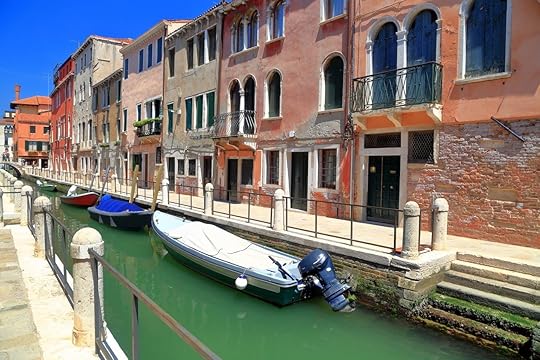
Photo: Inu/Shutterstock
There’s a cost-benefit equation to waiting in long lines. When not everyone in the family is excited by what comes at the end of that queue — a likely scenario when you have kids of very different ages and interests — the balance tips in favor of blowing out of there. Fast.
The same goes for lingering in crowded parts of town. The magic of Venice doesn’t stop at St. Mark’s Square, which is jammed with cruise-shippers every summer day. Leave the city center and instead wander the backstreets of neighborhoods like Dorsoduro. Only the most cynical child won’t be amazed to find houses with their own boats, where elsewhere they’d see a car. Don’t think of your time in outlying neighborhoods as missing the top sights. Instead, regard it as a chance to get a more authentic picture of a place.
8. Consider sleeping arrangements.
Little ones may wake at dawn while teens prefer to rise at the crack of noon. On days when you have early morning plans, a noisy toddler may do a good job of rousing your teenager. That, however, is a risky strategy.
You don’t want to start the day with a crabby, resentful older kid. If you at least give the younger child breakfast first, the older kid will feel they got to sleep in a bit. If you’re all in one hotel room, one parent should be prepared to get up early and make a swift getaway with the little one.
Conversely, at night, let the older child watch a movie on their phone in the lobby — with or without a nearby parent, depending on their age — while the younger kid gets settled to sleep. If you have two hotel rooms, you may want to split up kids and parents to accommodate the dissimilar sleep patterns. Renting an Airbnb so you’re not all sharing a single room or two can resolve the sleep-time dilemma altogether.
9. Be creative.

Photo: shun2u/Shutterstock
Another good thing about letting older kids do some research is they may come up with ideas you wouldn’t have thought of — like strolling the hipster shops of Seattle’s Capitol Hill neighborhood (which has also has leafy playgrounds for the siblings) or checking out the graffiti and art-strewn John Lennon Wall in Prague.
You can also be creative and add in different activities. We’ve already mentioned riding bikes. Likewise, unless your kids are too young for long walks, consider hiking. Treks give kids the fresh air they crave, often come with great views, and are an all-family activity. It’s also easy to hike near many cities in Europe and the US.
10. Don’t underestimate your kids.
Too often, people don’t travel with their kids because they anticipate it not working out. You never know until you try. In new contexts, kids may be more adaptable. You’ve probably already seen how your kid eats food at a friend’s house they won’t eat at home, or how your kid behaves better with grandma.
Take them traveling. You may find the older kid stepping in to help out and the younger one growing up just a little bit.
11. Eat ice cream.

Photo: Alena Ozerova/Shutterstock
While the best release for most young kids is running around a playground or park, that’s not always possible. Your next best option may be a special treat — like ice cream, crepes, or the local pastry. Truth is, older kids love ice cream just as much as the little ones, and we’re willing to bet you do too. 

More like this: 7 epic family trips that aren’t Disney World
The post How to travel when your kids are different ages appeared first on Matador Network.

When is smoke season in Thailand

It’s effortless to envision the world in which we travel as a paradise worthy of our footprint. But there comes a time when every explorer must face the ecological issues that plague our planet in real time. When you’re shrouded in a smoky haze amidst the dry, dusty streets of Northern Thailand, that problem becomes impossible to ignore.
Smoke season in Northern Thailand is something a lot of travelers intentionally bypass. Meanwhile, expats flee the region like swarming cicadas, waiting to return until the monsoon season comes to wash away the forest and crop fires that surround. Other adventurers are unaware of the haze that comes each year until they’re in it and try to stick it out until the pollutants finally push them out. Whether you’ve accidentally found yourself planning a trip in the dead of smoke season or you’re trying to plan around it, here’s everything you need to know about smoke season in Northern Thailand.
When Pai’s gone dry
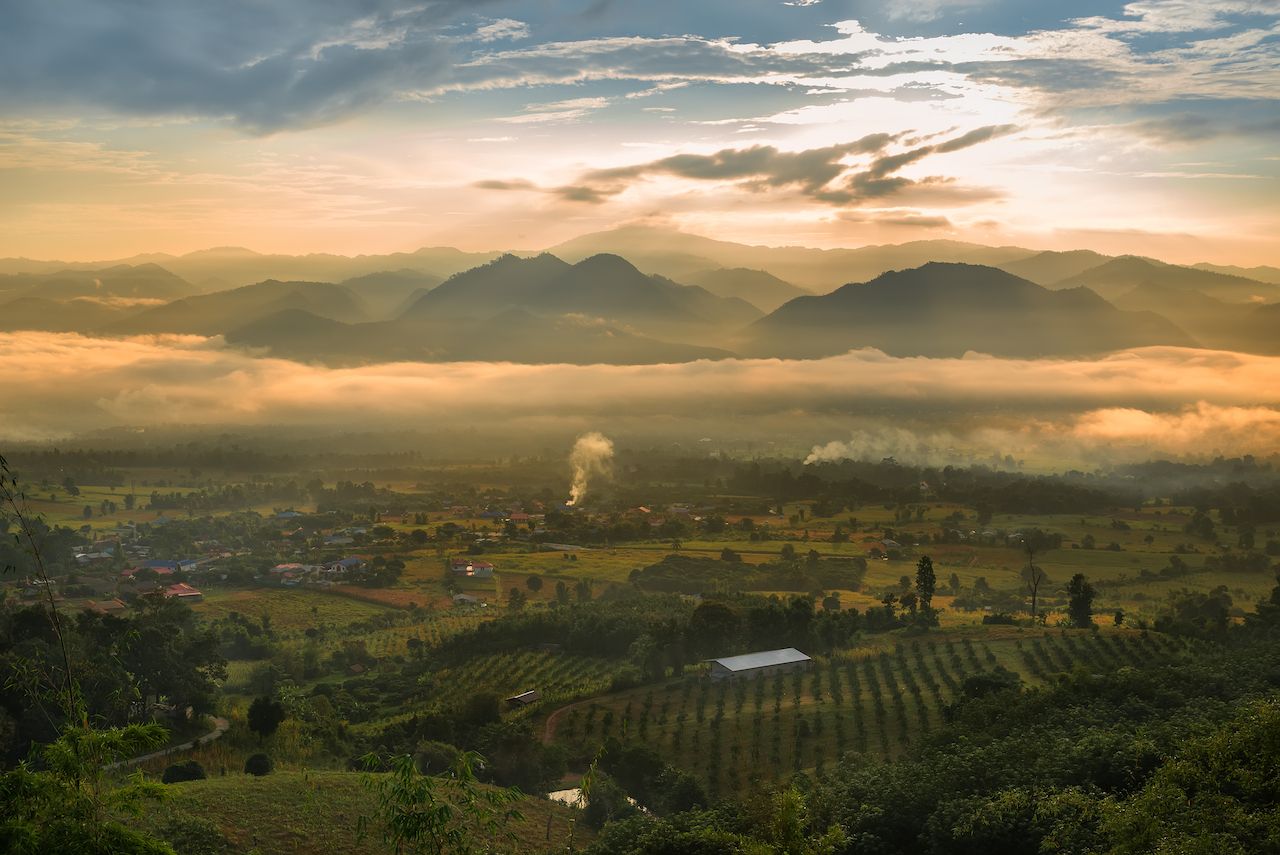
Photo: YP_Studio/Shutterstock
The majestic, mountainous Pai region in Thailand’s north is stunning regardless of what time of year it is. The sun rising over the veined Pai canyon, the water buffalo grazing beside the babbling river of the same name — it’s all a bucolic scene worthy of a visit. However, when the rain halts for the season and the river dims its splash, smoke from farmers shedding their crops begins to set in. For a few weeks in March and April, the pollution levels in these regions near the maximum rating of 500 on the AQI Scale issued by the US Environmental Protection Agency. Add natural and man-made forest fires to the mix, and haze often overtakes the area beginning in late February.
In the cities of Chiang Mai and Chiang Rai, and further north in the Mae Hong Son province, smoke season is a real thing, and pollutant-protecting masks are there to prove it. Chiang Mai — home of Doi Suthep, North Gate Jazz Co-Op, and a number of other tourist-friendly attractions — was named the worst air quality in the world for weeks in March of this year. Sometimes, the fires burn in the hills overnight, giving the morning a hazy hue and ashy aroma.
How it starts: burnt fields across multiple borders
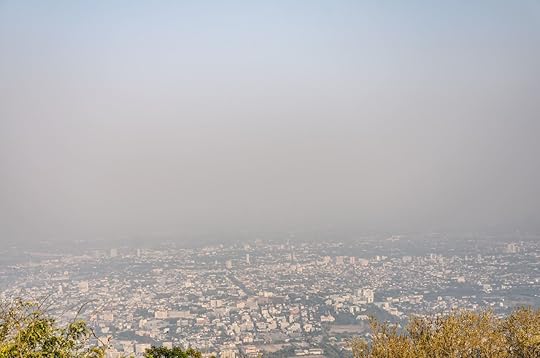
Photo: worapojnuntaa/Shutterstock
Thai farmers burn their rice and other leftover crops during the dry season to clear the land. So do their surrounding neighbors in Myanmar and Laos. Through Global Forest Watch, an online fire tracker, anyone can pose witness to the forest and crop fires burning amidst this perfect border-bound storm as they occur.
As of March 1, 2019, burning crops in Thailand became outlawed, but according to the forest fires I saw across the valley as I sat along the Pai river this March, it’s a rule that doesn’t seem to be strictly followed. Throughout the month, as I ventured into different regions of the north, the haze continued to build.
The smoke never dimmed the shine of a thick bowl of khao soi, nor did it make banal a splendid (however smog-shaded) sunset. But beautiful and enriching as northern Thailand may be, I eventually chose to ditch the north altogether, having spent enough time breathing through a pollutant-filtering mask and feeling my sinuses clog up unwillingly.
The further south you head, the less the fires blaze. Even in bustling Bangkok, where motorbikes and smoke-spewing songthaews (truck taxis) reign supreme, the air quality index was rather calm compared to its northern provincial relatives, though a haze still hung in the air. By the time you make south it to Surat Thani or the islands of the Chumphon Archipelago (home of the famous Full Moon Party, Koh Phangan), you may just realize that the cold that’s been dragging on was really a physiological reaction to too much pollution, and all is now well and good.
The ashen takeaway

Photo: Nitikorn Poonsiri/Shutterstock
Burning fields is something that’s been going on in Thailand for centuries. Because these farmers typically don’t have big machinery to pull out roots and start anew each season, this minimizes the time and effort the laborers have to spend in the fields. Locals from packed places like Old Town, Chiang Mai as well as secluded regions like Ban Rak Thai, Mae Hong Son cannot just leave for the season. They must stick it out, ingesting harmful pollutants year after year, waiting at long last for the rains to come and rejuvenate the air.
The recent ban on crop burning is complemented by efforts to increase awareness on the harmful effects of heightened air pollution. Many areas across northern Thailand host seminars, hang signs, and spearhead funding for farmers to begin to develop alternatives. There’s even a short film called Smoke that lays about the health effects of living amidst dense fire pollution.
But as of 2019, air pollution is still a very big problem in the area. Wearing a mask in public places is commonplace and recommended. Pharmacies often run out of filtered masks, leaving tourists to peck their heads into every outlet until they can find the mask they’re after. Be sure to stock up before you leave your home country if you’re set on toughing out the haze.
Smoke season aside, northern Thailand is a splendid locale. Immeasurably welcoming hospitality, peaceful spirituality, and a landscape as varied as the cuisine all define this region. I will forever remember the sun rising over the Pai Canyon, not a soul in sight — though I will remember it tucked behind a haze as I watched with a mask donning my awestruck face. 

More like this: Thailand’s best dishes are found in Chiang Mai, not Bangkok
The post What to know about smoke season in Northern Thailand appeared first on Matador Network.

Traditional Bulgarian yogurt dishes

Yogurt has been a part of what is present-day Bulgaria since long before modern borders were drawn. It’s believed that the first yogurts in the area came from nomadic tribes around 4,000 years ago when their milk fermented in animal-skin flasks. The Balkans have the proper bacteria and temperature to naturally produce yogurt, making it an important ingredient throughout the region’s history.
Today, yogurt (or kiselo mlyako as they sometimes call it in Bulgaria, meaning sour milk) is eaten around the world. But it was the Bulgarian scientist Stamen Grigorov who discovered the bacteria, lactobacillus bulgaricus, needed to turn the milk into yogurt. And it’s in the Bulgarian village of Studen Izvor where you’ll find the only yogurt museum in the world. No country lays claim to yogurt like Bulgaria does, and the best way to see for yourself is through all of the classic yogurt-laced dishes in the country.
1. Tarator

Photo: Olga Dubravina/Shutterstock
One of the first foods you’ll want to try in Bulgaria. Tarator is cold soup made from Bulgarian yogurt, cucumber, water, and other ingredients that’s somewhat like a gazpacho. In the past, the dish was served to people working in the fields, especially during harvesting season (this version is known as “harvester’s tarator”). You can find it made with Bulgarian yogurt around the country today thanks to the local love for anything with that special “sour milk.” Yogurt gives modern tarator its slight tang, and it’s cool and refreshing taste make it perfect on a hot summer day.
2. Musaka

Photo: Taratorki/Shutterstock
While a version of musaka is made in Greece and throughout the Balkans and Middle East, the Bulgarian recipe is on a different level. The base of the dish is minced meat and potatoes, usually with some carrots, bell peppers, and a lot of spices, but what makes it stand out is a topping made from Bulgarian yogurt, eggs, and flour that’s poured over the musaka a few minutes before it’s done in the oven. It’s served hot and topped with even more Bulgarian yogurt straight out of the fridge. The dish comes from the Ottomans who ruled parts of the Balkans from the 14th century up to the 20th century.
3. Sarma

Photo: Yakov Filimonov/Shutterstock
A true Slavic meal. Visitors to the Balkans, and especially Bulgaria, will be scolded for not having tried sarmas despite coming from a country where the dish is hardly known. Locals will go out of their way to fix that, so don’t be surprised if you get handed a Tupperware container full of strange-looking bite-sized leaf wraps. Sarmas are made with meat and grain that’s wrapped in zeleva (cabbage) or lozova (grape) leaves, and they’re inextricable from Balkan culture. No matter what the stuffing is or which leaf is used as a wrapping, they’re eaten topped with Bulgarian yogurt. Grape leaf and rice sarmas are vegan and have grown in popularity among the younger generation, especially around the holidays, but they absolutely require that special yogurt as a topping, otherwise the dish is considered incomplete.
4. Yaitsa po Panagiyurski, or Panagyurisht-styled eggs

Photo: Vania Georgieva/Shutterstock
An extremely simple recipe yet amazingly tasty. Kiselo mlyako is mixed with garlic and spread in a deep plate. Cottage cheese is sprinkled over the top, making a nice bed for the three or four poached eggs that follow. Molten butter mixed with paprika is poured on top, and voila! This is a perfect breakfast dish, provided you have no trouble poaching eggs and have access to Bulgarian yogurt, without which the recipe simply doesn’t work. Panagyurishte is a town in Bulgaria, and the story goes that it was invented by a Panagyurishte woman as a way to greet and impress her son-in-law. The dish spread to the others in the town although no one knows exactly when or who first created it. One thing is certain, though: today, you can find yaitsa po Panagiyurski everywhere in Bulgaria.
5. Banitsa

Photo: Marta Maziar/Shutterstock
This, along with tarator, might be the most recognizable part of Bulgarian cuisine. Banitsa is prepared by layering filo pastry with eggs and cottage cheese and baking it in the oven. The result is a super crunchy, salty, and hearty pastry that can be eaten either hot or cold and is primarily served for breakfast in Bulgaria. On New Year’s Eve, it’s served with little dogwood branches hidden in the crust, and when someone finds the branches, they get to keep a charm that symbolizes health, longevity, and luck. Surprisingly, for a dish that has turned into a symbol for the nation and is present in almost all holiday recipe books in Bulgaria, there’s no knowledge of when or where it came from. And, of course, it’s not banitsa without a serving of kiselo mlyako. 

More like this: The 7 healthiest cuisines in the world you should learn to cook
The post 5 dishes that prove Bulgarian yogurt is the best yogurt appeared first on Matador Network.

Cannabis dispensary etiquette

If you’ve never been to a recreational cannabis dispensary before, the first time can be a little daunting. But according to Amy Andrle, the co-owner of Denver’s L’Eagle dispensary (one of Matador’s Denver favorites), there’s nothing to worry about, even if you’re a newbie.
“As consumers, I think there are too many people who are nervous about going into a shop, but they are the reason the shop is open,” she says.
In other words, the dispensary salespeople are there to help you on your cannabis journey, whether you’re a seasoned user or are new to marijuana. And even though shops like L’Eagle are welcoming to everyone, Andrle suggests knowing the proper dispensary etiquette before you walk inside. Catch up on some basics you need to know before your first dispensary visit, and be sure to follow these essential dos and don’ts before you go.
Do ask the right questions.
If you’re walking into a recreational marijuana dispensary, you already know you’re going to find a variety of flower, edibles, and topical products. But knowing where the cannabis is coming from is just as important to make sure you’re buying a reputable brand and product. “Ask about testing,” Andrle says. “Ask where it’s cultivated.” Educating yourself on the full range of products available will make you a better cannabis consumer.
Do understand dosing.
One of the best things about legal marijuana is dosing regulations. Gone are the days of picking up a magic brownie and taking a wild guess as to how much cannabis is actually lurking inside. While there’s still a minor margin of error allowed in things like edibles, you know what you’re getting for the most part. But even so, knowing what a standard dose is will help guide you in your shopping experience, even if you’re new to cannabis.
“You don’t go shopping for a car, walk in and say, ‘uh, I’m looking for a car,’” Andrle says. “Because you’ll probably be taken advantage of. There’s more research to do on your part.” Familiarize yourself with dosage and be honest about your usage with the sales attendant so they can help you find the proper products instead of selling you something that could be way too strong for your body.
Don’t bring your pet inside.
Unless you require a service dog, Andrle explains that although they love animals, they don’t allow them in the store for sanitary reasons. “Understand why some people would say no,” she says. “For me, this is stuff I’m either eating or lighting on fire and smoking. I don’t want someone else’s pet fur and dander all over it.” L’Eagle has a shaded patio in the front of their store where dogs are welcome to hang while their owners shop. If you’re unsure of the pet policy, call the store and ask, or simply leave Fido at home.
Do know where you can consume legally.
Even if you smell cannabis wafting in the streets, that doesn’t mean you’re allowed to light up in the middle of the sidewalk. Even in the best cities for recreational cannabis consumers, there are strict laws that determine where you’re allowed to smoke your purchases. “Know where you can consume legally in the state in which you’re purchasing it,” Andrle says. “When you walk out the door, you can’t just light up a joint walking down the street. It’s not the coolest thing to do because you’re jeopardizing the compliance of the store where you bought it. So that would be rude.”
Do come with the appropriate photo ID.
This seems like a no-brainer, but Andrle explained that people forget to bring proper identification more than you might think. Cannabis dispensaries are running a tight ship, so you won’t be able to sweet talk your way inside without proper ID, no matter how mature you may look. Just like you check for your passport before leaving for an international flight, triple check that you have your ID before going to a dispensary.
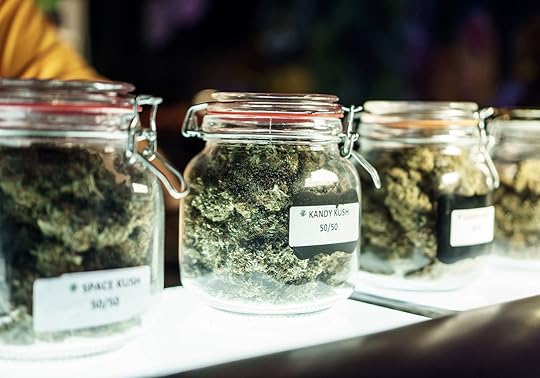
Photo: Brandon Crawford/Shutterstock
Don’t purchase more than you should have.
If you live in a state where cannabis isn’t legal, we understand how exciting it is to walk into a dispensary and have so many amazing products suddenly at your fingertips. But states with legal recreational marijuana have purchasing limits, and Andrle explains that knowing those limits is important when you visit a dispensary. Familiarize yourself with the law so you don’t put yourself or the store in a compromising position.
Do be able to articulate what you like or don’t like.
“Talk openly about your previous experience with cannabis so that whoever is helping you can be informed,” Andrle says. Perhaps you had a bad experience with a particular strain, or maybe you stick to one type of flower because it’s tried and true for you. Whether it’s explaining a pleasant cannabis experience or talking about one that you don’t want to relive, that information is important in helping the salesperson guide you in the right direction and suggesting the appropriate products for you. If your previous cannabis experience is little to none, that’s okay too, just make sure they know so they can recommend flower and edibles that are suitable for a first-timer.
Don’t take a photo without asking.
We’ve been in stores where photos are allowed, and we’ve also been in some where they are discouraged. If you’re unsure, always inquire. “Ask the proprietor or salesperson if it’s appropriate or not because that varies from store to store,” Andrle says. “Some people are going to love it, social media wise. We’re protective for security issues because you don’t know if the person asking to take photos is really taking a picture of the room to try and check out where the camera locations are. Do be respectful that it’s somebody’s space, but don’t be afraid to ask.” 

More like this: The best recreational cannabis dispensaries in America
The post Cannabis dispensary etiquette: dos and don’ts to know before you go appeared first on Matador Network.

Matador Network's Blog
- Matador Network's profile
- 6 followers



